Beer F.P., Johnston E.R., DeWolf J.T., Mazurek D.F. Mechanics of Materials
Подождите немного. Документ загружается.

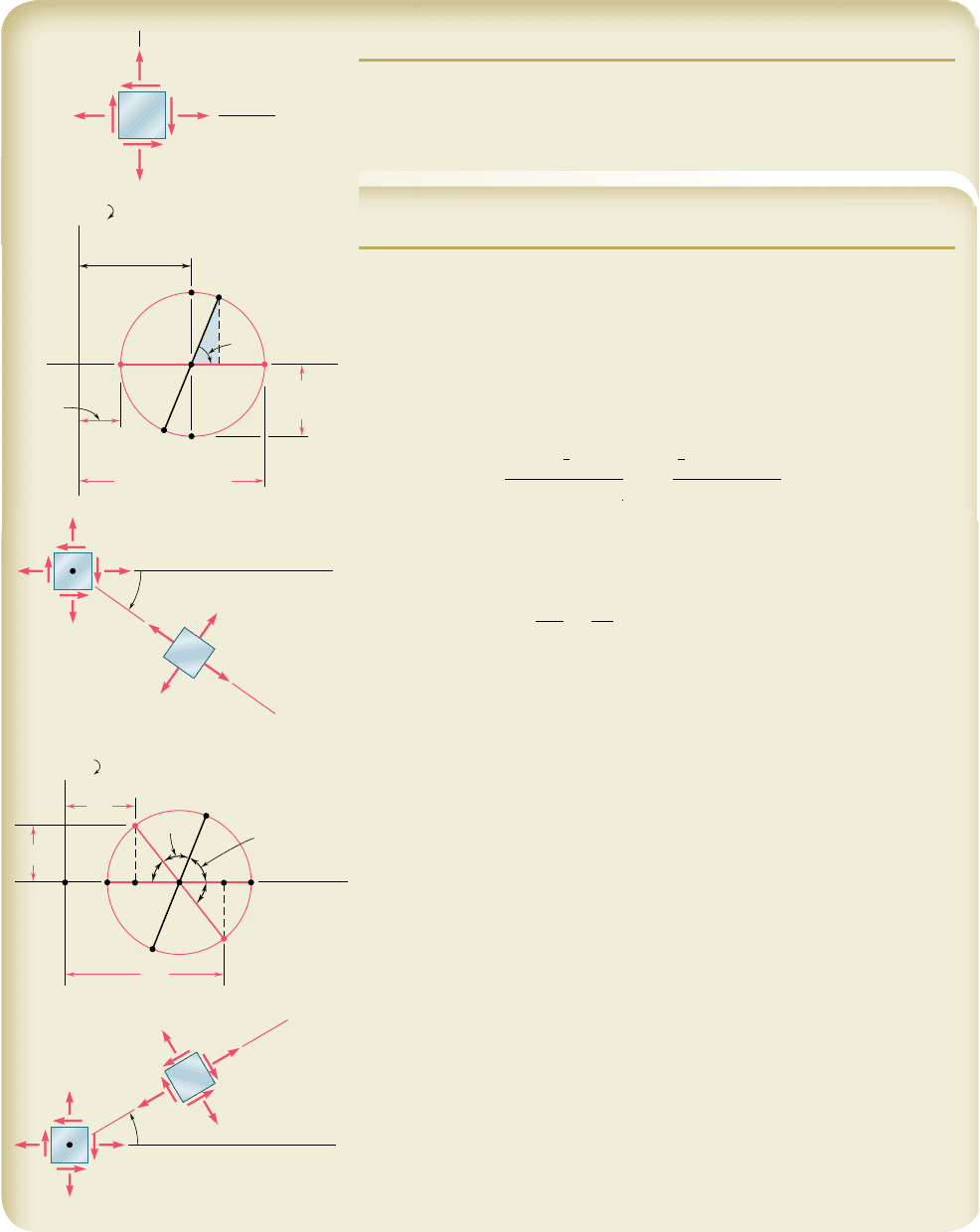
Apago PDF Enhancer
457
SAMPLE PROBLEM 7.2
For the state of plane stress shown, determine (a) the principal planes and
the principal stresses, (b) the stress components exerted on the element
obtained by rotating the given element counterclockwise through 308.
SOLUTION
Construction of Mohr’s Circle. We note that on a face perpendicular
to the x axis, the normal stress is tensile and the shearing stress tends to rotate
the element clockwise; thus, we plot X at a point 100 units to the right of
the vertical axis and 48 units above the horizontal axis. In a similar fashion, we
examine the stress components on the upper face and plot point Y(60, 248).
Joining points X and Y by a straight line, we define the center C of Mohr’s
circle. The abscissa of C, which represents
s
ave
, and the radius R of the circle
can be measured directly or calculated as follows:
s
ave
5 OC 5
1
2
1s
x
1 s
y
25
1
2
1100 1 6025 80 MPa
R 5 21CF2
2
1 1FX2
2
5 21202
2
1 1482
2
5 52 MPa
a. Principal Planes and Principal Stresses. We rotate the diameter
XY clockwise through 2u
p
until it coincides with the diameter AB. We have
tan 2u
p
5
XF
C
F
5
48
20
5 2.4
2u
p
5 67.4° i u
p
5 33.7° ib
The principal stresses are represented by the abscissas of points A and B:
s
m
a
x
5 OA 5 OC 1 CA 5 80 1 52 s
max
51132 MPab
s
m
i
n
5 OB 5 OC 2 BC 5 80 2 52 s
min
51 28 MPab
Since the rotation that brings XY into AB is clockwise, the rotation that
brings Ox into the axis Oa corresponding to
s
max
is also clockwise; we obtain
the orientation shown for the principal planes.
b. Stress Components on Element Rotated 308
l
. Points X9 and Y9
on Mohr’s circle that correspond to the stress components on the rotated
element are obtained by rotating X Y counterclockwise through
2u 5 608.
We find
f 5 180° 2 60° 2 67.4° f 5 52.6°b
s
x
¿
5 OK 5 OC 2 KC 5 80 2 52 cos 52.6° s
x¿
51 48.4 MPab
s
y¿
5 OL 5 OC 1 CL 5 80 1 52 cos 52.6° s
y¿
51111.6 MPab
t
x¿y¿
5 KX¿ 5 52 sin 52.6° t
x¿y¿
5 41.3 MPab
Since X9 is located above the horizontal axis, the shearing stress on the face
perpendicular to O x9 tends to rotate the element clockwise.
x
O
p
33.7
min
28 MPa
max
132 MPa
a
2 60
OB
K
X
L
C
A
Y
Y'
(MPa)
180 60 67.4
52.6
2
p
67.4
(MPa)
X'
x'
y'
x'y'
x
O
30
y'
111.6 MPa
x'
48.4 MPa
x'y'
41.3 MPa
x'
2
O
B
X(100, 48)
R
F
C
Y(60, 48)
A
(MPa)
min
28 MPa
m
52 MPa
ave
80 MPa
p
max
132 MPa
(MPa)
60 MPa
100 MPa
48 MPa
y
x
bee80288_ch07_436-511.indd Page 457 10/30/10 1:39:11 AM user-f499bee80288_ch07_436-511.indd Page 457 10/30/10 1:39:11 AM user-f499 /Users/user-f499/Desktop/Temp Work/Don't Delete Job/MHDQ251:Beer:201/ch07/Users/user-f499/Desktop/Temp Work/Don't Delete Job/MHDQ251:Beer:201/ch07
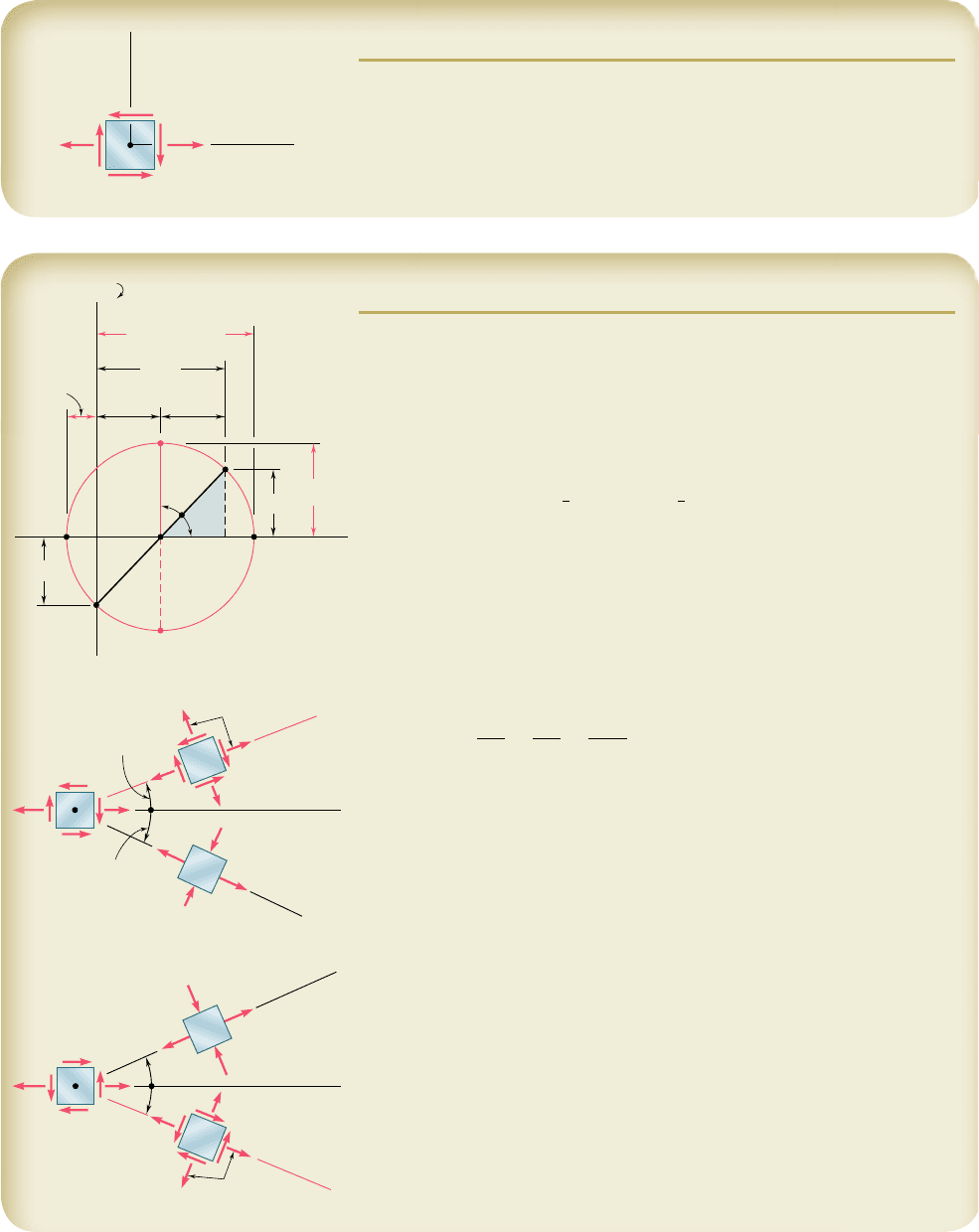
Apago PDF Enhancer
458
SAMPLE PROBLEM 7.3
A state of plane stress consists of a tensile stress s
0
5 8 ksi exerted on verti-
cal surfaces and of unknown shearing stresses. Determine (a) the magnitude
of the shearing stress t
0
for which the largest normal stress is 10 ksi, (b) the
corresponding maximum shearing stress.
SOLUTION
Construction of Mohr’s Circle. We assume that the shearing stresses
act in the senses shown. Thus, the shearing stress t
0
on a face perpendicular
to the x axis tends to rotate the element clockwise and we plot the point X
of coordinates 8 ksi and t
0
above the horizontal axis. Considering a horizontal
face of the element, we observe that s
y
5 0 and that t
0
tends to rotate the
element counterclockwise; thus, we plot point Y at a distance t
0
below O.
We note that the abscissa of the center C of Mohr’s circle is
s
ave
5
1
2
1s
x
1 s
y
25
1
2
18 1 025 4 ksi
The radius R of the circle is determined by observing that the maximum
normal stress, s
max
5 10 ksi, is represented by the abscissa of point A
and writing
s
max
5 s
ave
1 R
10 ksi 5 4 ksi 1 R
R 5 6 ksi
a. Shearing Stress t
0.
Considering the right triangle CFX, we find
cos 2
u
p
5
C
F
CX
5
CF
R
5
4 ksi
6 ksi
2 u
p
5 48.2° i u
p
5 24.1° i
t
0
5 FX 5 R sin 2u
p
5 16 ksi2 sin 48.2° t
0
5 4.47 ksib
b. Maximum Shearing Stress. The coordinates of point D of Mohr’s
circle represent the maximum shearing stress and the corresponding normal
stress.
t
max
5 R 5 6 ksi t
max
5 6 ksib
2
u
s
5 90° 2 2 u
p
5 90° 2 48.2° 5 41.8° lu
x
5 20.9° l
The maximum shearing stress is exerted on an element that is oriented as
shown in Fig. a. (The element upon which the principal stresses are exerted
is also shown.)
Note. If our original assumption regarding the sense of t
0
was
reversed, we would obtain the same circle and the same answers, but the
orientation of the elements would be as shown in Fig. b.
0
0
8 ksi
0
0
y
x
O
2
p
2
2 ksi
s
(ksi)
min
4 ksi 4 ksi
8 ksi
ave
max
10 ksi
D
R
CO
E
Y
FA
X
B
0
0
max
(ksi)
x
d
a
O
s
20.9
p
24.1
0
0
ave
4 ksi
max
6 ksi
min
2 ksi
max
10 ksi
(a)
x
O
24.1
20.9
0
0
min
2 ksi
max
10 ksi
max
6 ksi
ave
4 ksi
(b)
bee80288_ch07_436-511.indd Page 458 10/30/10 1:39:23 AM user-f499bee80288_ch07_436-511.indd Page 458 10/30/10 1:39:23 AM user-f499 /Users/user-f499/Desktop/Temp Work/Don't Delete Job/MHDQ251:Beer:201/ch07/Users/user-f499/Desktop/Temp Work/Don't Delete Job/MHDQ251:Beer:201/ch07

Apago PDF Enhancer
PROBLEMS
459
7.31 Solve Probs. 7.5 and 7.9, using Mohr’s circle.
7.32 Solve Probs. 7.7 and 7.11, using Mohr’s circle.
7.33 Solve Prob. 7.10, using Mohr’s circle.
7.34 Solve Prob. 7.12, using Mohr’s circle.
7.35 Solve Prob. 7.13, using Mohr’s circle.
7.36 Solve Prob. 7.14, using Mohr’s circle.
7.37 Solve Prob. 7.15, using Mohr’s circle.
7.38 Solve Prob. 7.16, using Mohr’s circle.
7.39 Solve Prob. 7.17, using Mohr’s circle.
7.40 Solve Prob. 7.18, using Mohr’s circle.
7.41 Solve Prob. 7.19, using Mohr’s circle.
7.42 Solve Prob. 7.20, using Mohr’s circle.
7.43 Solve Prob. 7.21, using Mohr’s circle.
7.44 Solve Prob. 7.22, using Mohr’s circle.
7.45 Solve Prob. 7.23, using Mohr’s circle.
7.46 Solve Prob. 7.24, using Mohr’s circle.
7.47 Solve Prob. 7.25, using Mohr’s circle.
7.48 Solve Prob. 7.26, using Mohr’s circle.
7.49 Solve Prob. 7.27, using Mohr’s circle.
7.50 Solve Prob. 7.28, using Mohr’s circle.
7.51 Solve Prob. 7.29, using Mohr’s circle.
7.52 Solve Prob. 7.30, using Mohr’s circle.
7.53 Solve Prob. 7.30, using Mohr’s circle and assuming that the weld
forms an angle of 608 with the horizontal.
bee80288_ch07_436-511.indd Page 459 10/30/10 1:39:34 AM user-f499bee80288_ch07_436-511.indd Page 459 10/30/10 1:39:34 AM user-f499 /Users/user-f499/Desktop/Temp Work/Don't Delete Job/MHDQ251:Beer:201/ch07/Users/user-f499/Desktop/Temp Work/Don't Delete Job/MHDQ251:Beer:201/ch07
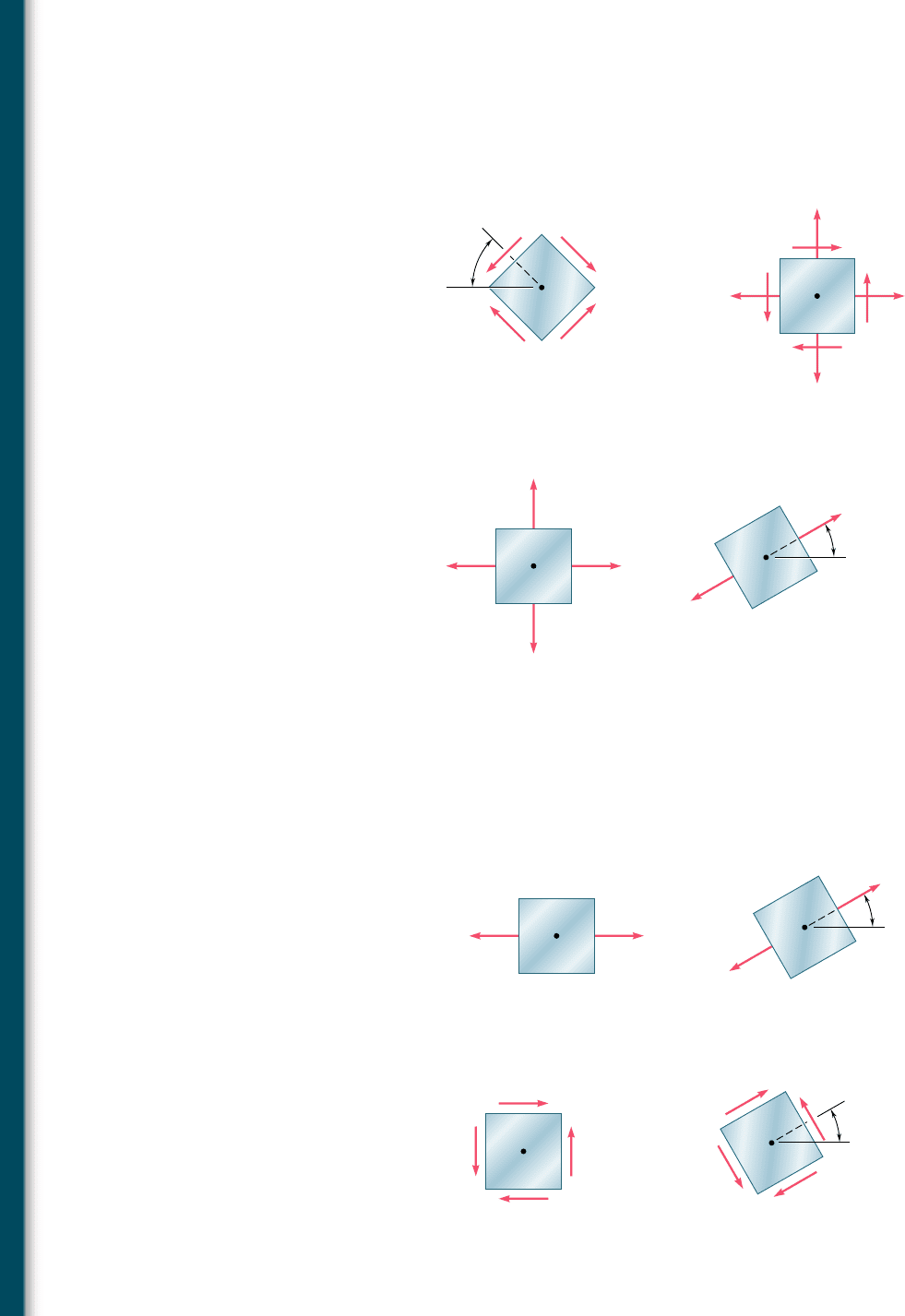
Apago PDF Enhancer
460
Transformations of Stress and Strain
7.54 and 7.55 Determine the principal planes and the principal
stresses for the state of plane stress resulting from the superposi-
tion of the two states of stress shown.
7 ksi
4 ksi
6 ksi
4 ksi
45
+
Fig. P7.54
25 MPa
40 MP
a
35 MPa
30
+
Fig. P7.55
7.56 and 7.57 Determine the principal planes and the principal
stresses for the state of plane stress resulting from the superposi-
tion of the two states of stress shown.
0
0
+
Fig. P7.56
0
0
30
+
Fig. P7.57
bee80288_ch07_436-511.indd Page 460 10/30/10 1:39:35 AM user-f499bee80288_ch07_436-511.indd Page 460 10/30/10 1:39:35 AM user-f499 /Users/user-f499/Desktop/Temp Work/Don't Delete Job/MHDQ251:Beer:201/ch07/Users/user-f499/Desktop/Temp Work/Don't Delete Job/MHDQ251:Beer:201/ch07
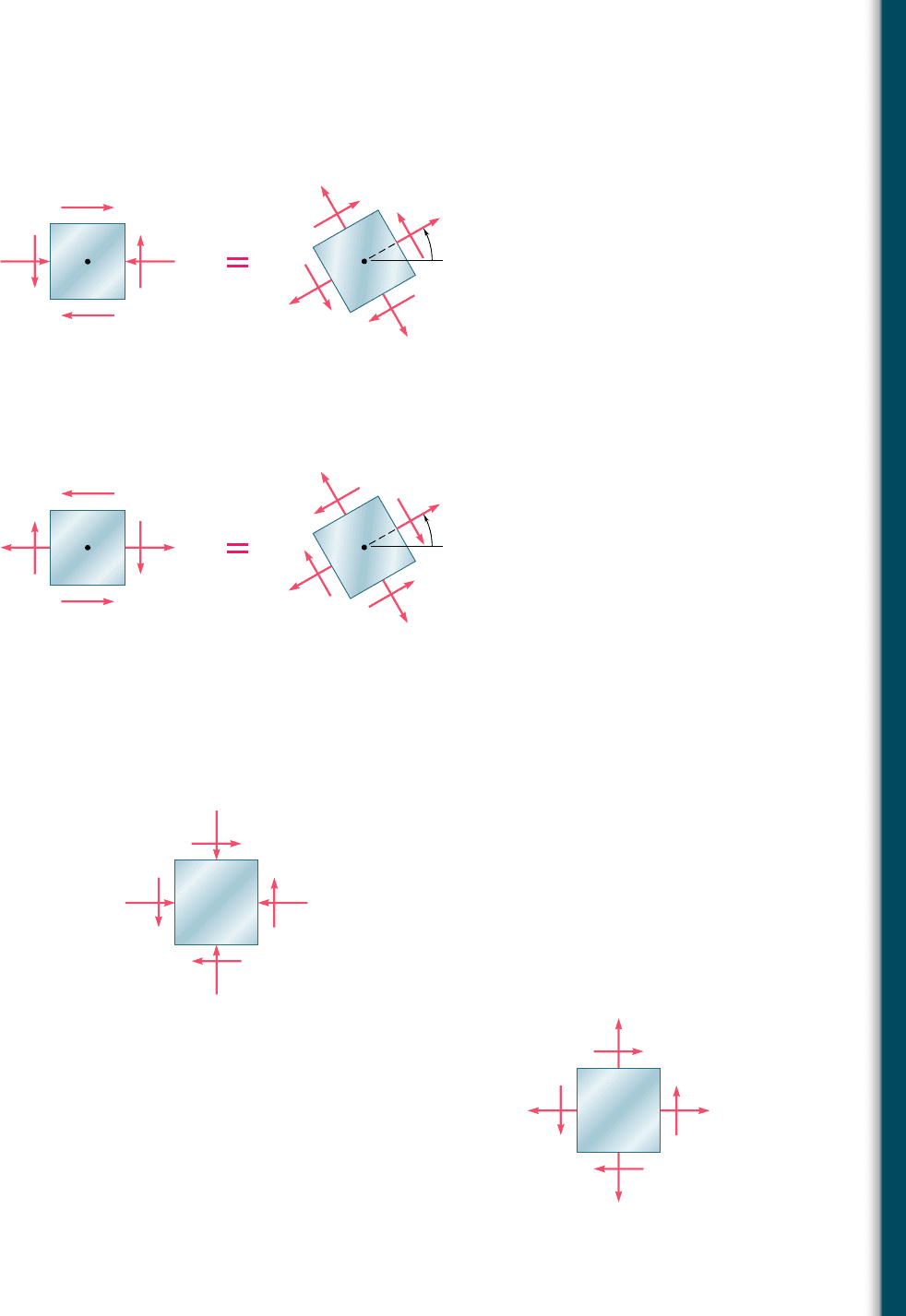
Apago PDF Enhancer
461
Problems
7.60 For the state of stress shown, determine the range of values of u
for which the normal stress s
x9
is equal to or less than 100 MPa.
7.61 For the element shown, determine the range of values of t
xy
for
which the maximum tensile stress is equal to or less than 60 MPa.
7.58 For the state of stress shown, determine the range of values of u
for which the magnitude of the shearing stress t
x9y9
is equal to or
less than 8 ksi.
7.59 For the state of stress shown, determine the range of values of u
for which the normal stress s
x9
is equal to or less than 50 MPa.
y'
x
'
x'y'
16 ksi
6 ksi
Fig. P7.58
90 MPa
60 MPa
y'
x
'
x'y'
Fig. P7.59 and P7.60
xy
120 MPa
20 MP
a
Fig. P7.61 and P7.62
7.62 For the element shown, determine the range of values of t
xy
for
which the maximum in-plane shearing stress is equal to or less than
150 MPa.
7.63 For the state of stress shown it is known that the normal and shear-
ing stresses are directed as shown and that s
x
5 14 ksi, s
y
5 9 ksi,
and s
min
5 5 ksi. Determine (a) the orientation of the principal
planes, (b) the principal stress s
max
, (c) the maximum in-plane
shearing stress.
xy
y
x
Fig. P7.63
bee80288_ch07_436-511.indd Page 461 10/30/10 1:39:44 AM user-f499bee80288_ch07_436-511.indd Page 461 10/30/10 1:39:44 AM user-f499 /Users/user-f499/Desktop/Temp Work/Don't Delete Job/MHDQ251:Beer:201/ch07/Users/user-f499/Desktop/Temp Work/Don't Delete Job/MHDQ251:Beer:201/ch07
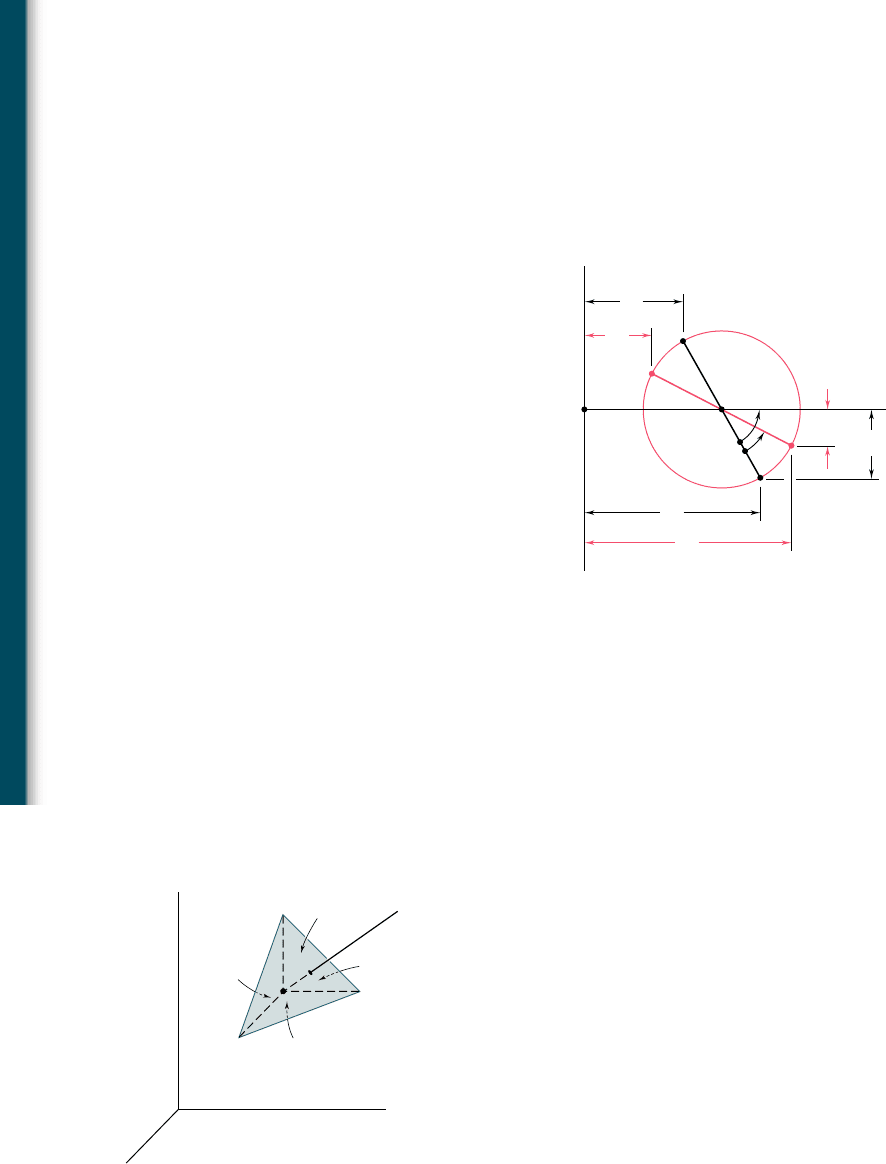
Apago PDF Enhancer
7.64 The Mohr’s circle shown corresponds to the state of stress given
in Fig. 7.5a and b. Noting that s
x9
5 OC 1 (CX9) cos (2u
p
2 2u)
and that t
x9y9
5 (CX9) sin (2u
p
2 2u), derive the expressions for s
x9
and t
x9y9
given in Eqs. (7.5) and (7.6), respectively. [Hint: Use
sin (A 1 B) 5 sin A cos B 1 cos A sin B and cos (A 1 B) 5 cos A
cos B 2 sin A sin B.]
x'y'
xy
y
y'
x'
x
X'
Y
Y'
O
C
X
2
p
2
Fig. P7.64
7.65 (a) Prove that the expression s
x9
s
y9
2 t
2
x9y9
, where s
x9
, s
y9
, and t
x9y9
are components of the stress along the rectangular axes x9 and y9, is
independent of the orientation of these axes. Also, show that the
given expression represents the square of the tangent drawn from
the origin of the coordinates to Mohr’s circle. (b) Using the invari-
ance property established in part a, express the shearing stress t
xy
in terms of s
x
, s
y
, and the principal stresses s
max
and s
min
.
7.5 GENERAL STATE OF STRESS
In the preceding sections, we have assumed a state of plane stress
with s
z
5 t
zx
5 t
zy
5 0, and have considered only transformations
of stress associated with a rotation about the z axis. We will now
consider the general state of stress represented in Fig. 7.1a and the
transformation of stress associated with the rotation of axes shown
in Fig. 7.1b. However, our analysis will be limited to the determina-
tion of the normal stress s
n
on a plane of arbitrary orientation.
Consider the tetrahedron shown in Fig. 7.23. Three of its faces
are parallel to the coordinate planes, while its fourth face, ABC, is
perpendicular to the line QN. Denoting by DA the area of face ABC,
and by l
x
, l
y
, l
z
the direction cosines of line QN, we find that the
areas of the faces perpendicular to the x, y, and z axes are, respec-
tively, (DA)l
x
, (DA)l
y
, and (DA)l
z
. If the state of stress at point Q is
defined by the stress components s
x
, s
y
, s
z
, t
xy
, t
yz
, and t
zx
, then
the forces exerted on the faces parallel to the coordinate planes can
be obtained by multiplying the appropriate stress components by the
area of each face (Fig. 7.24). On the other hand, the forces exerted
on face ABC consist of a normal force of magnitude s
n
DA directed
along QN, and of a shearing force of magnitude t DA perpendicular
to QN but of otherwise unknown direction. Note that, since QBC,
x
z
y
O
C
B
Q
N
A
( A)
z
( A)
y
( A)
x
A
Fig. 7.23
462
Transformations of Stress and Strain
bee80288_ch07_436-511.indd Page 462 10/30/10 1:39:52 AM user-f499bee80288_ch07_436-511.indd Page 462 10/30/10 1:39:52 AM user-f499 /Users/user-f499/Desktop/Temp Work/Don't Delete Job/MHDQ251:Beer:201/ch07/Users/user-f499/Desktop/Temp Work/Don't Delete Job/MHDQ251:Beer:201/ch07
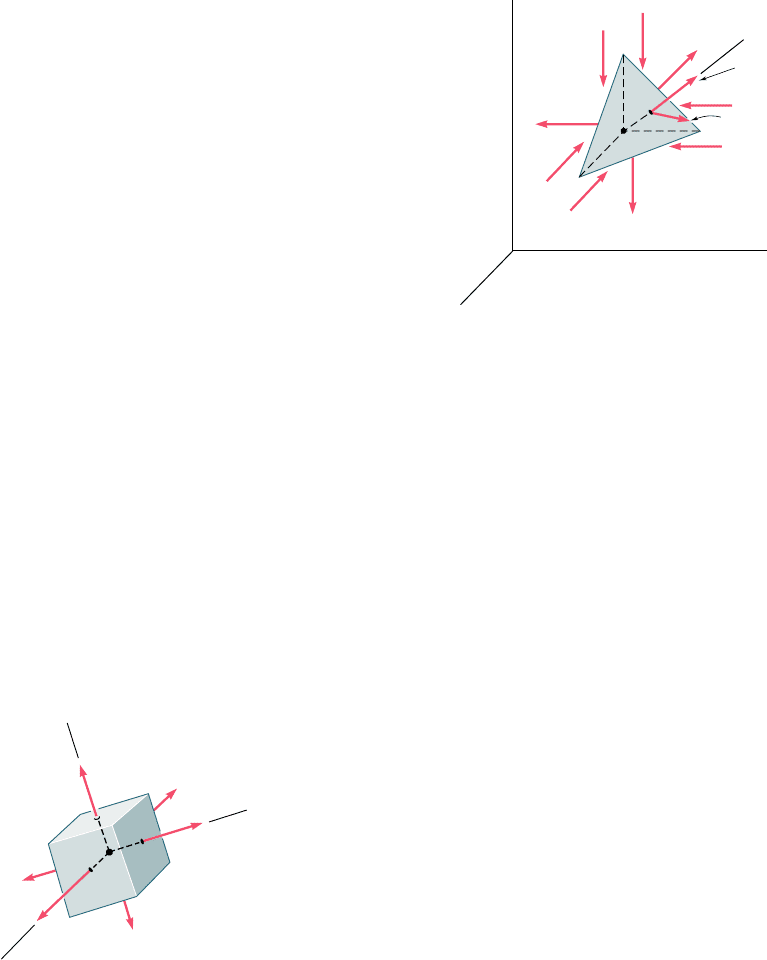
Apago PDF Enhancer
463
QCA, and QAB, respectively, face the negative x, y, and z axes, the
forces exerted on them must be shown with negative senses.
We now express that the sum of the components along QN of
all the forces acting on the tetrahedron is zero. Observing that the
component along QN of a force parallel to the x axis is obtained by
multiplying the magnitude of that force by the direction cosine l
x
,
and that the components of forces parallel to the y and z axes are
obtained in a similar way, we write
g
F
n
5 0: s
n
¢A 2
1
s
x
¢A l
x
2
l
x
2
1
t
x
y
¢A l
x
2
l
y
2
1
t
xz
¢A l
x
2
l
z
2
1
t
y
x
¢A l
y
2
l
x
2
1
s
y
¢A l
y
2
l
y
2
1
t
y
z
¢A l
y
2
l
z
2
1
t
zx
¢A l
z
2
l
x
2
1
t
z
y
¢A l
z
2
l
y
2
1
s
z
¢A l
z
2
l
z
5 0
Dividing through by DA and solving for s
n
, we have
s
n
5 s
x
l
2
x
1 s
y
l
2
y
1 s
z
l
2
z
1 2t
x
y
l
x
l
y
1 2t
y
z
l
y
l
z
1 2t
zx
l
z
l
x
(7.20)
We note that the expression obtained for the normal stress s
n
is a quadratic form in l
x
, l
y
, and l
z
. It follows that we can select the
coordinate axes in such a way that the right-hand member of Eq.
(7.20) reduces to the three terms containing the squares of the direc-
tion cosines.† Denoting these axes by a, b, and c, the corresponding
normal stresses by s
a
, s
b
, and s
c
, and the direction cosines of QN
with respect to these axes by l
a
, l
b
, and l
c
, we write
s
n
5 s
a
l
2
a
1 s
b
l
2
b
1 s
c
l
2
c
(7.21)
The coordinate axes a, b, c are referred to as the principal axes
of stress. Since their orientation depends upon the state of stress at
Q, and thus upon the position of Q, they have been represented in
Fig. 7.25 as attached to Q. The corresponding coordinate planes are
known as the principal planes of stress, and the corresponding nor-
mal stresses s
a
, s
b
, and s
c
as the principal stresses at Q.‡
7.5 General State of Stress
†In Sec. 9.16 of F. P. Beer and E. R. Johnston, Vector Mechanics for Engineers, 9th ed.,
McGraw-Hill Book Company, 2010, a similar quadratic form is found to represent the
moment of inertia of a rigid body with respect to an arbitrary axis. It is shown in Sec. 9.17
that this form is associated with a quadric surface, and that reducing the quadratic form
to terms containing only the squares of the direction cosines is equivalent to determining
the principal axes of that surface.
‡For a discussion of the determination of the principal planes of stress and of the principal
stresses, see S. P. Timoshenko and J. N. Goodier, Theory of Elasticity, 3d ed., McGraw-
Hill Book Company, 1970, Sec. 77.
x
z
y
O
C
B
Q
N
A
A
y
yx
A
yy
A
y
yz
A
x
xz
A
x
xy
A
z
zy
A
z
A
z
z
A
n
zx
A
A
x
x
Fig. 7.24
a
a
b
b
c
c
Q
a
c
b
Fig. 7.25 Principal stresses.
bee80288_ch07_436-511.indd Page 463 10/30/10 1:39:57 AM user-f499bee80288_ch07_436-511.indd Page 463 10/30/10 1:39:57 AM user-f499 /Users/user-f499/Desktop/Temp Work/Don't Delete Job/MHDQ251:Beer:201/ch07/Users/user-f499/Desktop/Temp Work/Don't Delete Job/MHDQ251:Beer:201/ch07
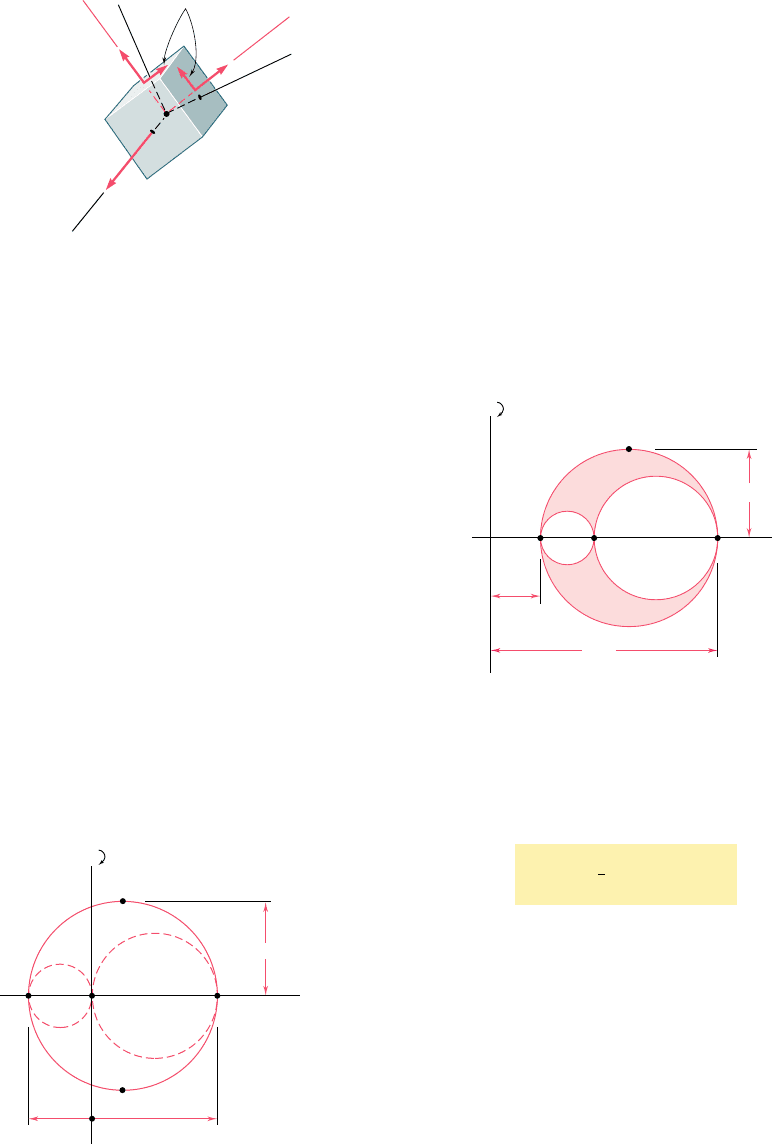
Apago PDF Enhancer
464
Transformations of Stress and Strain
7.6 APPLICATION OF MOHR’S CIRCLE TO THE THREE-
DIMENSIONAL ANALYSIS OF STRESS
If the element shown in Fig. 7.25 is rotated about one of the principal
axes at Q, say the c axis (Fig. 7.26), the corresponding transformation
of stress can be analyzed by means of Mohr’s circle as if it were a
transformation of plane stress. Indeed, the shearing stresses exerted
on the faces perpendicular to the c axis remain equal to zero, and the
normal stress s
c
is perpendicular to the plane ab in which the trans-
formation takes place and, thus, does not affect this transformation.
We therefore use the circle of diameter AB to determine the normal
and shearing stresses exerted on the faces of the element as it is
rotated about the c axis (Fig. 7.27). Similarly, circles of diameter BC
and CA can be used to determine the stresses on the element as it is
rotated about the a and b axes, respectively. While our analysis will be
limited to rotations about the principal axes, it could be shown that
any other transformation of axes would lead to stresses represented in
Fig. 7.27 by a point located within the shaded area. Thus, the radius
xy
y
x
c
b
y
Q
c
x
a
Fig. 7.26
O
C
B
A
min
max
max
Fig. 7.27 Mohr’s circles for general
state of stress.
of the largest of the three circles yields the maximum value of the
shearing stress at point Q. Noting that the diameter of that circle is
equal to the difference between s
max
and s
min
, we write
t
max
5
1
2
0
s
max
2 s
min
0
(7.22)
where s
max
and s
min
represent the algebraic values of the maximum
and minimum stresses at point Q.
Let us now return to the particular case of plane stress, which
was discussed in Secs. 7.2 through 7.4. We recall that, if the x and
y axes are selected in the plane of stress, we have s
z
5 t
zx
5 t
zy
5
0. This means that the z axis, i.e., the axis perpendicular to the plane
of stress, is one of the three principal axes of stress. In a Mohr-circle
diagram, this axis corresponds to the origin O, where s 5 t 5 0.
We also recall that the other two principal axes correspond to points
A and B where Mohr’s circle for the xy plane intersects the s axis.
If A and B are located on opposite sides of the origin O (Fig. 7.28),
Z OB
D
E
A
min
max
max
Fig. 7.28
bee80288_ch07_436-511.indd Page 464 10/30/10 1:40:02 AM user-f499bee80288_ch07_436-511.indd Page 464 10/30/10 1:40:02 AM user-f499 /Users/user-f499/Desktop/Temp Work/Don't Delete Job/MHDQ251:Beer:201/ch07/Users/user-f499/Desktop/Temp Work/Don't Delete Job/MHDQ251:Beer:201/ch07
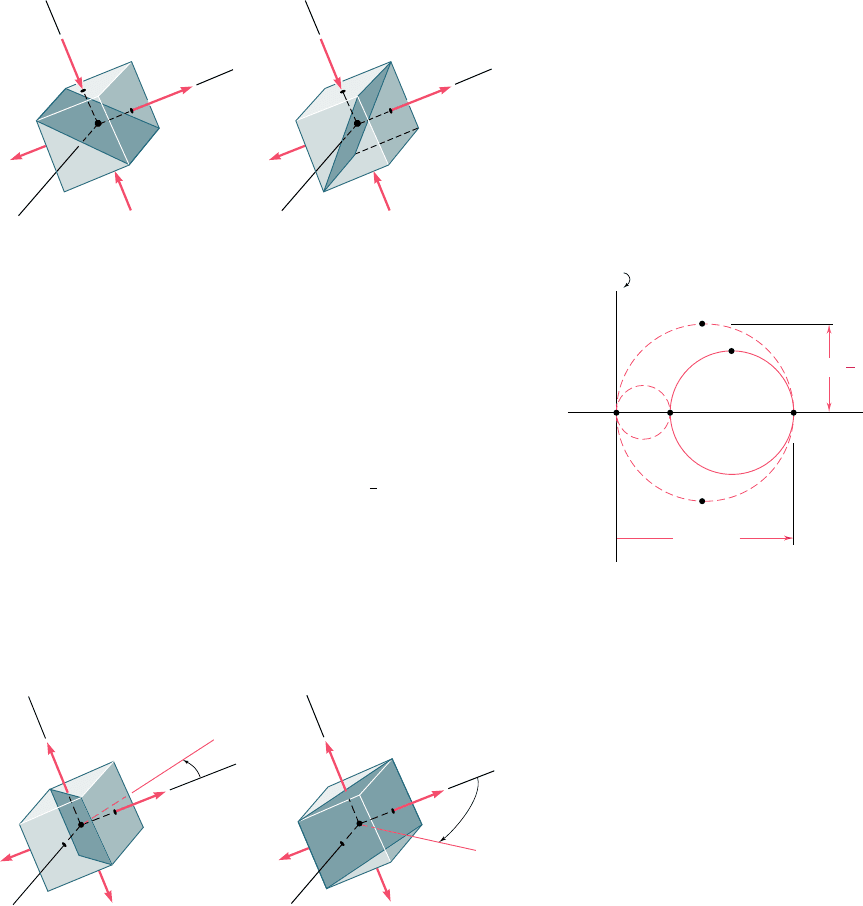
Apago PDF Enhancer
465
the corresponding principal stresses represent the maximum and
minimum normal stresses at point Q, and the maximum shearing
stress is equal to the maximum “in-plane” shearing stress. As noted
in Sec. 7.3, the planes of maximum shearing stress correspond to
points D and E of Mohr’s circle and are at 458 to the principal planes
corresponding to points A and B. They are, therefore, the shaded
diagonal planes shown in Figs. 7.29a and b.
7.6 Application of Mohr’s Circle to the Three-
Dimensional Analysis of Stress
a
a
b
b
Q
a
z
b
a
a
b
b
Q
a
z
b
(a)(b)
Fig. 7.29
Z O
B
A
0
min
max
max
D'
E'
D
1
2
a
a
Fig. 7.30
a
a
b
b
Q
a
b
z
45
a
a
b
b
Q
a
b
e'
z
(b)(a)
45
d'
Fig. 7.31
If, on the other hand, A and B are on the same side of O, that
is, if s
a
and s
b
have the same sign, then the circle defining s
max
,
s
min
, and t
max
is not the circle corresponding to a transformation of
stress within the xy plane. If s
a
. s
b
. 0, as assumed in Fig. 7.30,
we have s
max
5 s
a
, s
min
5 0, and t
max
is equal to the radius of the
circle defined by points O and A, that is, t
max
5
1
2
s
max
. We also note
that the normals Qd9 and Qe9 to the planes of maximum shearing
stress are obtained by rotating the axis Qa through 458 within the za
plane. Thus, the planes of maximum shearing stress are the shaded
diagonal planes shown in Figs. 7.31a and b.
bee80288_ch07_436-511.indd Page 465 10/30/10 1:40:09 AM user-f499bee80288_ch07_436-511.indd Page 465 10/30/10 1:40:09 AM user-f499 /Users/user-f499/Desktop/Temp Work/Don't Delete Job/MHDQ251:Beer:201/ch07/Users/user-f499/Desktop/Temp Work/Don't Delete Job/MHDQ251:Beer:201/ch07
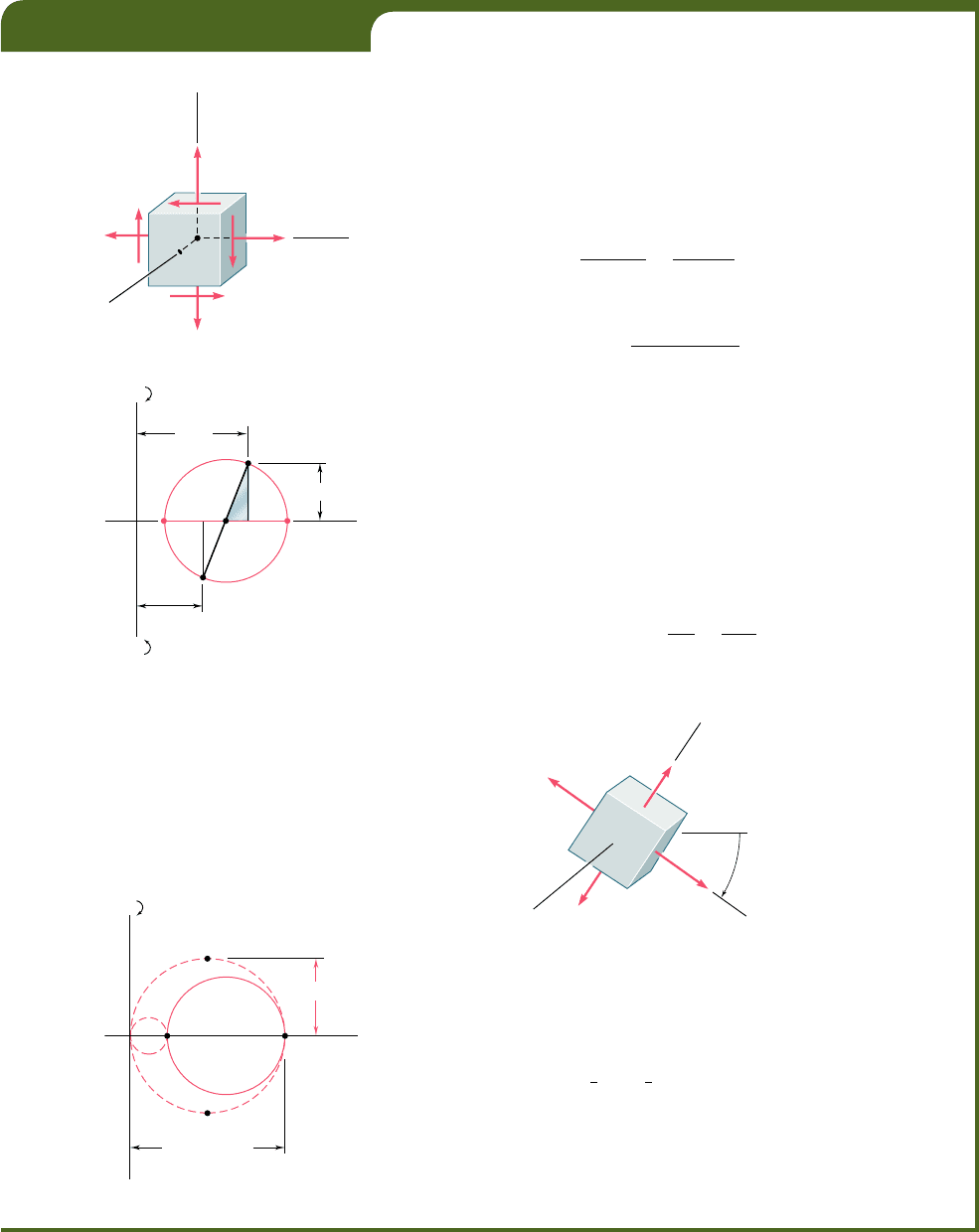
Apago PDF Enhancer
466
For the state of plane stress shown in Fig. 7.32, determine (a) the three
principal planes and principal stresses, (b) the maximum shearing stress.
(a) Principal Planes and Principal Stresses. We construct
Mohr’s circle for the transformation of stress in the xy plane (Fig. 7.33).
Point X is plotted 6 units to the right of the t axis and 3 units above the
s axis (since the corresponding shearing stress tends to rotate the element
clockwise). Point Y is plotted 3.5 units to the right of the t axis and 3
units below the s axis. Drawing the line XY, we obtain the center C of
Mohr’s circle for the xy plane; its abscissa is
s
ave
5
s
x
1
s
y
2
5
6 1 3.5
2
5 4.75 ksi
Since the sides of the right triangle CFX are CF 5 6 2 4.75 5 1.25 ksi
and FX 5 3 ksi, the radius of the circle is
R 5 CX 5 2
1
1.25
2
2
1
1
3
2
2
5 3.25 ksi
The principal stresses in the plane of stress are
s
a
5 OA 5 OC 1 CA 5 4.75 1 3.25 5 8.00
k
si
s
b
5 OB 5 OC 2 BC 5 4.75 2 3.25 5 1.50
k
si
Since the faces of the element that are perpendicular to the z axis are
free of stress, these faces define one of the principal planes, and the corre-
sponding principal stress is s
z
5 0. The other two principal planes are
defined by points A and B on Mohr’s circle. The angle u
p
through which the
element should be rotated about the z axis to bring its faces to coincide with
these planes (Fig. 7.34) is half the angle ACX. We have
tan 2u
p
5
F
X
C
F
5
3
1
.
25
2u
p
5 6
7
.4° i u
p
5 33.
7
° i
EXAMPLE 7.03
Fig. 7.32
Q
z
x
y
3.5 ksi
3 ksi
6 ksi
Fig. 7.33
O
B
X
F
C
Y
A
3 ksi
3.5 ksi
6 ksi
b
x
a
z
1.50 ksi
1.50 ksi
8.00 ksi
8.00 ksi
p
Fig. 7.34
OB
A
a
max
E'
D'
8.00 ksi
Fig. 7.35
(b) Maximum Shearing Stress. We now draw the circles of diame-
ter OB and OA, which correspond respectively to rotations of the element
about the a and b axes (Fig. 7.35). We note that the maximum shearing
stress is equal to the radius of the circle of diameter OA. We thus have
t
max
5
1
2
s
a
5
1
2
1
8.00 ksi
2
5 4.00 ksi
Since points D9 and E9, which define the planes of maximum shearing
stress, are located at the ends of the vertical diameter of the circle cor-
responding to a rotation about the b axis, the faces of the element of Fig.
7.34 can be brought to coincide with the planes of maximum shearing
stress through a rotation of 458 about the b axis.
bee80288_ch07_436-511.indd Page 466 10/30/10 1:40:16 AM user-f499bee80288_ch07_436-511.indd Page 466 10/30/10 1:40:16 AM user-f499 /Users/user-f499/Desktop/Temp Work/Don't Delete Job/MHDQ251:Beer:201/ch07/Users/user-f499/Desktop/Temp Work/Don't Delete Job/MHDQ251:Beer:201/ch07
